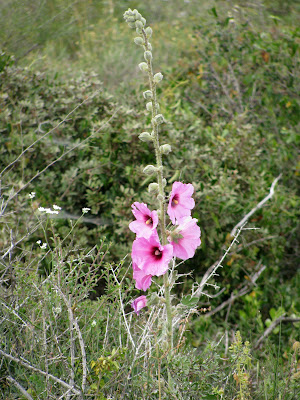We'd been to Ramat Hanadiv, the elegant formal gardens built as a living memorial to Baron Edmond de Rothschild, before, but it was only recently that I discovered that there are some wonderful hiking trails in the area as well. Friends took us on the Manor Trail back in January where we passed Horvat Aqav, the remains of a Byzantine farmhouse, and enjoyed beautiful views overlooking the Carmel coast. During Passover we went back to show my Dad the gardens and also to try out another trail, The Spring Trail, overlooking the Nadiv Valley.
The Spring Trail was an easy 2.5 kilometre hike which lead to the Ein Tsur spring. The views en route were magnificent, though the winter flowers - the rakefot and kalaniot - seen in abundance earlier in the year, were all gone.
People inhabited the Ein Tsur area 10,000 years ago. During the Herodian period there was a big village there. Our walk led us past remains of the walls and towers that surrounded the village and storage rooms. The main reason that people settled at this site was the spring located at the bottom of the hill. The Romans built an aqueduct, a large pool to store the water and a bath house there.
There are three rooms inside the bath house - the cold room, the tepid room which was used to get your body used to the heat, and then the hot room where steam opened the body's pores and helped clean your skin.
After admiring the bath house we wandered towards the spring. A tunnel was carved from the spring to increase the flow of water. A stream of water flows along a covered canal which prevents dirt getting into it. Finally this canal reaches the storage pools, where the water was used as drinking water for animals, for the bath house and swimming, and also a reservoir that supplied water for agricultural use.
The spring at Ein Tsur has also been called 'The Spring of Fertility'. The Bordeaux Pilgrim, an anonymous traveller who visited the Holy Land in 333, made particular note of the spring and wrote that women who wash in it become pregnant. An important find at the spring was a hoard of 2,000 coins dating from the early fourth century to the seventh century. It is believed that they were thrown in by women seeking cures for their infertility, like a kind of wishing well.
We passed a columbarium on our way back up the hill. The Romans built a special tower near the spring, above, to house pigeons. This tower was called a columbarium, from the Latin word "columbary", meaning dove or pigeon. In order to grow crops the settlers needed water, but also fertiliser too and pigeon droppings were perfect. The pigeons could also be used for food and for religious purposes.
We continued following the trail past Beit Khouri, an Ottoman era farmhouse, later inhabited by a Christian family. Here the farm manager and workers lived in large vaulted rooms, along with the animals they cared for. The remains of a mosque, built by the Christian el-Khouri family for their Muslim farm workers, can also be seen. This building later served as a dining hall for a group of pioneers who settled the site after Baron Edmond de Rothschild purchased the land in 1913. During the following years three groups of Halutzim (pioneers) settled at the site, but they faced very hard conditions. The rocky land was hard to cultivate and the rooms teemed with insects from the area of the spring. Malaria took a heavy toll on the settlers but, despite the hardships, they lived in the area for several years and managed to dry out the swamps.




































3 comments:
Lovely photos Lisa. I do love an easy 2.5 kilometre hike! Unfortunately, we often find our hikes turning into part mountain climbing exercises which I don't find quite so much fun.
Great photos Lisa. The ancient culture here sounds like a very clean bunch! Interesting theory of the wishing well. I guess the coin in a fountain wishes go way back in time! That first flower photo is so beautiful. I have never seen a flower like that one before!
Great collection of photos, I love your flower shots. Sounds like it was an amazing day of history and beauty.
Valerie
Everyday Inspired
Post a Comment